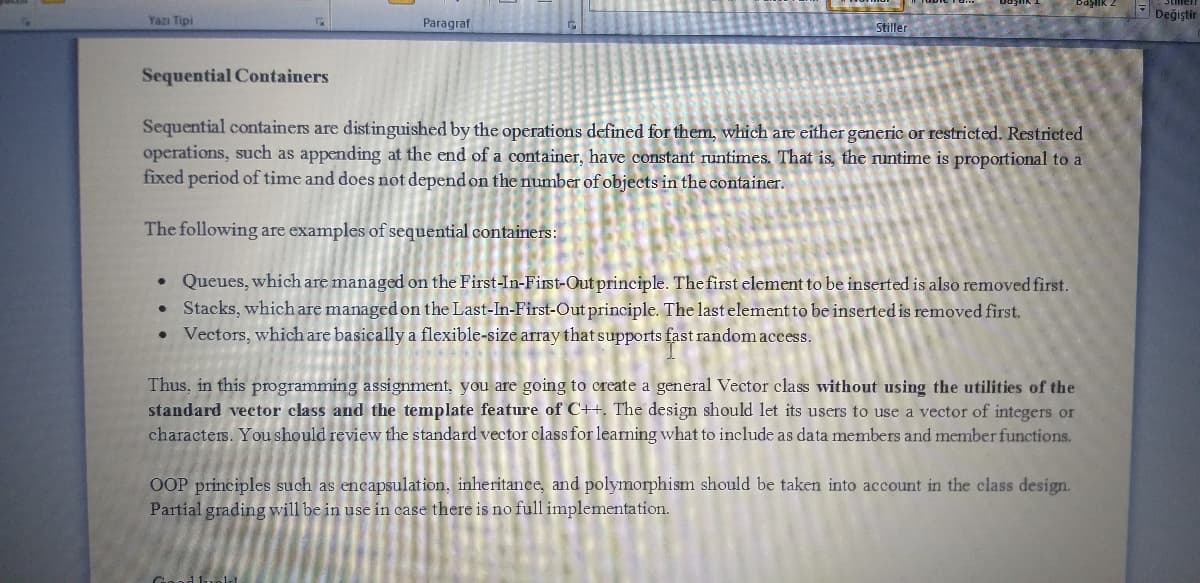the objects are generally organized and managed in a tree structure and can be referenced using keys. Sequential Containers Sequential containers are distinguished by the operations defined for them, which are either generic or restricted. Restricted operations, such as appending at the end of a container, have constant runtimes. That is, the runtime is proportional to a fixed period of time and does not depend on the number of objects in the container. The following are examples of sequential containers: Queues, which are managed on the First-In-First-Out principle. The first element to be inserted is also removed first. Stacks, which are managed on the Last-In-First-Out principle. The last element to be inserted is removed first. Vectors, which are basically a flexible-size array that supports fast random access. Thus, in this programming assignment, you are go
the objects are generally organized and managed in a tree structure and can be referenced using keys. Sequential Containers Sequential containers are distinguished by the operations defined for them, which are either generic or restricted. Restricted operations, such as appending at the end of a container, have constant runtimes. That is, the runtime is proportional to a fixed period of time and does not depend on the number of objects in the container. The following are examples of sequential containers: Queues, which are managed on the First-In-First-Out principle. The first element to be inserted is also removed first. Stacks, which are managed on the Last-In-First-Out principle. The last element to be inserted is removed first. Vectors, which are basically a flexible-size array that supports fast random access. Thus, in this programming assignment, you are go
Database System Concepts
7th Edition
ISBN:9780078022159
Author:Abraham Silberschatz Professor, Henry F. Korth, S. Sudarshan
Publisher:Abraham Silberschatz Professor, Henry F. Korth, S. Sudarshan
Chapter1: Introduction
Section: Chapter Questions
Problem 1PE
Related questions
Question

Transcribed Image Text:Değiştir
Yazı Tipi
Paragraf
Stiller
Sequential Containers
Sequential containers are distinguished by the operations defined for them, which are either generic or restricted. Restricted
operations, such as appending at the end of a container, have constant runtimes. That is, the runtime is proportional to a
fixed period of time and does not depend on the number of objects in the container.
The following are examples of sequential containers:
Queues, which are managed on the First-In-First-Out principle. The first element to be inserted is also removed first.
Stacks, which are managed on the Last-In-First-Out principle. The last element to be inserted is removed first.
Vectors, which are basically a flexible-size array that supports fast random access.
Thus, in this programming assignment, you are going to create a general Vector class without using the utilities of the
standard vector class and the template feature of C++. The design should let its users to use a vector of integers or
characters. You should review the standard vector class for learning what to include as data members and member functions.
OOP principles such as encapsulation. inheritance, and polymorphism should be taken into account in the class design.
Partial grading will be in use in case there is no full implementation.
Expert Solution
This question has been solved!
Explore an expertly crafted, step-by-step solution for a thorough understanding of key concepts.
Step by step
Solved in 2 steps

Knowledge Booster
Learn more about
Need a deep-dive on the concept behind this application? Look no further. Learn more about this topic, computer-science and related others by exploring similar questions and additional content below.Recommended textbooks for you

Database System Concepts
Computer Science
ISBN:
9780078022159
Author:
Abraham Silberschatz Professor, Henry F. Korth, S. Sudarshan
Publisher:
McGraw-Hill Education

Starting Out with Python (4th Edition)
Computer Science
ISBN:
9780134444321
Author:
Tony Gaddis
Publisher:
PEARSON

Digital Fundamentals (11th Edition)
Computer Science
ISBN:
9780132737968
Author:
Thomas L. Floyd
Publisher:
PEARSON

Database System Concepts
Computer Science
ISBN:
9780078022159
Author:
Abraham Silberschatz Professor, Henry F. Korth, S. Sudarshan
Publisher:
McGraw-Hill Education

Starting Out with Python (4th Edition)
Computer Science
ISBN:
9780134444321
Author:
Tony Gaddis
Publisher:
PEARSON

Digital Fundamentals (11th Edition)
Computer Science
ISBN:
9780132737968
Author:
Thomas L. Floyd
Publisher:
PEARSON

C How to Program (8th Edition)
Computer Science
ISBN:
9780133976892
Author:
Paul J. Deitel, Harvey Deitel
Publisher:
PEARSON

Database Systems: Design, Implementation, & Manag…
Computer Science
ISBN:
9781337627900
Author:
Carlos Coronel, Steven Morris
Publisher:
Cengage Learning

Programmable Logic Controllers
Computer Science
ISBN:
9780073373843
Author:
Frank D. Petruzella
Publisher:
McGraw-Hill Education